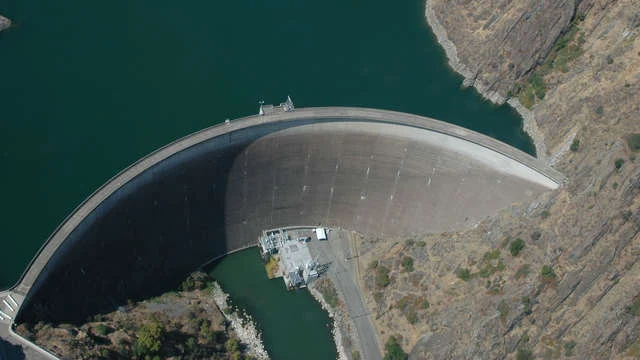Lonar Lake, also known as Lonar crater, is a notified National Geo-heritage Monument, saline, soda lake, located at Lonar in Buldhana district, Maharashtra, India. Lonar Lake was created by an asteroid collision with earthimpact during the Pleistocene Epoch. It is one of the four known, hyper-velocity, impact craters in basaltic rock anywhere on Earth. The other three basaltic impact structures are in southern Brazil. Lonar Lake has a mean diameter of 1.2 kilometres (3,900 ft) and is about 137 metres (449 ft) below the crater rim. The meteor crater rim is about 1.8 kilometers (5,900 ft) in diameter.
Lonar Crater sits inside the Deccan Plateau a massive plain of volcanic basalt rock created by eruptions some 65 million years ago. Its location in this basalt field suggested to some geologists that it was a volcanic crater. Today, however, Lonar Crater is understood to be the result of a meteorite impact that occurred between 35,000 and 50,000 years ago. The water in the lake is both saline and alkaline.
Geologists, ecologists, archaeologists, naturalists. and astronomers have published studies of various aspects of this crater lake ecosystem. the crater's age is usually estimated to be 52,000 ± 6,000 years, although a study published in 2010 gives an age of 570,000 ± 47,000 years. The Smithsonian Institution, the United States Geological Survey, Geological Survey of India, the University of Sagar and the Physical Research Laboratory have conducted extensive studies of the site. Biological nitrogen fixation was discovered in this lake in 2007. A recent study, conducted by IIT Bombay found that the minerals, in the lake soil, are very similar to the minerals found in moon rock brought back during Apollo Program.
Lonar Crater sits inside the Deccan Plateau a massive plain of volcanic basalt rock created by eruptions some 65 million years ago. Its location in this basalt field suggested to some geologists that it was a volcanic crater. Today, however, Lonar Crater is understood to be the result of a meteorite impact that occurred between 35,000 and 50,000 years ago. The water in the lake is both saline and alkaline.
Geologists, ecologists, archaeologists, naturalists. and astronomers have published studies of various aspects of this crater lake ecosystem. the crater's age is usually estimated to be 52,000 ± 6,000 years, although a study published in 2010 gives an age of 570,000 ± 47,000 years. The Smithsonian Institution, the United States Geological Survey, Geological Survey of India, the University of Sagar and the Physical Research Laboratory have conducted extensive studies of the site. Biological nitrogen fixation was discovered in this lake in 2007. A recent study, conducted by IIT Bombay found that the minerals, in the lake soil, are very similar to the minerals found in moon rock brought back during Apollo Program.
The water of the lake contains various salts and sodas. During dry weather, when evaporation reduces the water level, large quantities of soda are collected. Two small streams, named Purna and Penganga, drain into the lake, and a well of fresh water is located on the southern side, close to the water's edge.
Lonar Lake lies within the only known extraterrestrial impact crater found within the great Deccan Traps, a huge basaltic formation in India. The lake was initially believed to be of volcanic origin, but now it is recognized as an impact crater. Lonar Lake was created by the impact of either a Comet or of an Asteroid. The presence of plagioclase that has been either converted into Maskelynite or contains Planar deformation features has confirmed the impact origin of this crater. It is believed that only shock metamorphism caused by a hypervelocity impact can transform plagioclase into maskelynite, or create planar deformation features. The presence of impact deformation of basalt layers comprising the rim, of shocked Breccia inside the crater, of shatter cones, and of the non-volcanic Ejecta blanket surrounding the crater all support the impact origin of Lonar Lake.
The crater has an oval shape. The meteorite impact came from the east, at an angle of 35 to 40 degrees.There are various estimates of the age of the crater. Earlier thermoluminescence analyses gave a result of 52,000 years, while recent Argon-argon dating suggests that the crater is much older; it could be 570 000 ± 47 000 years old. This greater age is in line with the degree of erosion of the crater rim.
The crater has an oval shape. The meteorite impact came from the east, at an angle of 35 to 40 degrees.There are various estimates of the age of the crater. Earlier thermoluminescence analyses gave a result of 52,000 years, while recent Argon-argon dating suggests that the crater is much older; it could be 570 000 ± 47 000 years old. This greater age is in line with the degree of erosion of the crater rim.
For more information - Lonar Lake



















































